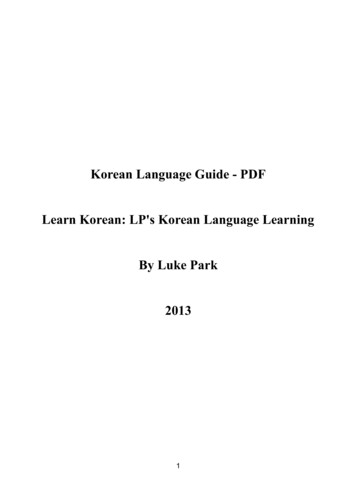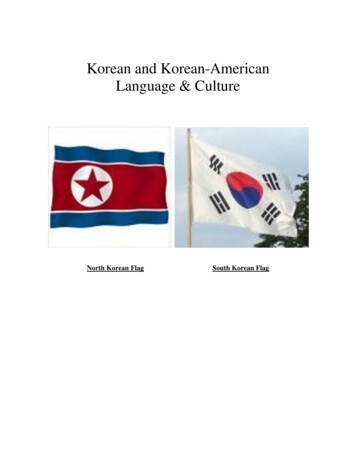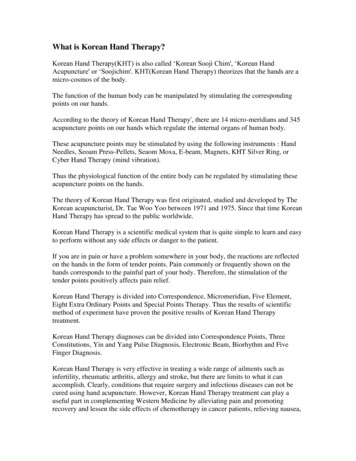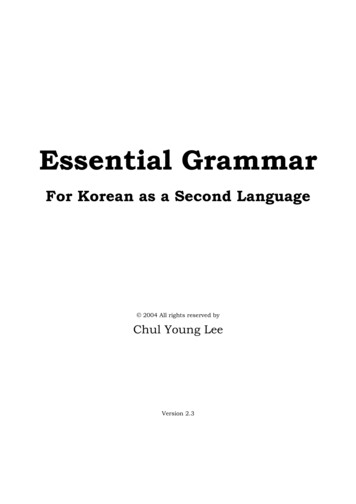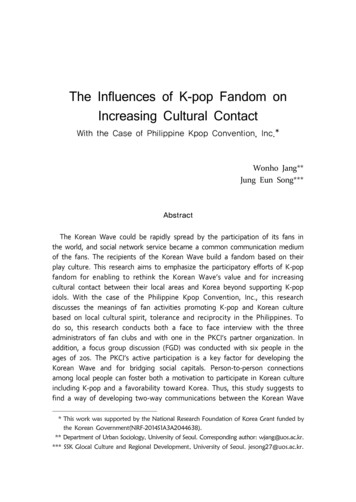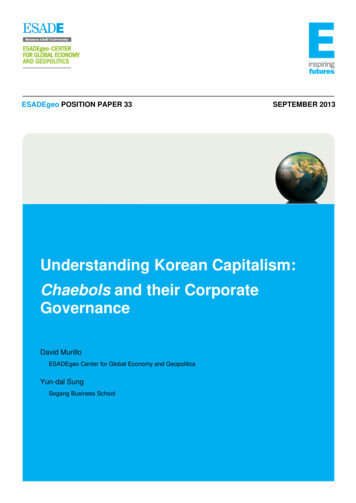
Transcription
ESADEgeo POSITION PAPER 33SEPTEMBER 2013Understanding Korean Capitalism:Chaebols and their CorporateGovernanceDavid MurilloESADEgeo Center for Global Economy and GeopoliticsYun-dal SungSogang Business School
Understanding Korean Capitalism:Chaebols and their Corporate Governance1David Murillo Yun-dal SungESADEgeo Center for Global Economics Sogang Business Schooland GeopoliticsSeptember 2013AbstractChaebols, Korean2 big business conglomerates, have had a huge influence in the globaleconomy and in Korean society and politics. Some stress the significant contributionchaebols have made to the unprecedented rapid development of the Korean economy, whileothers highlight their concomitant problems such as cronyism, corrupt relations withgovernment, and economic concentration. Although such problems seem to have beenreduced in recent years thanks to institutional pressures enacted by the Korean governmentafter the financial crisis of 1997, the pending reforms of the chaebol system are still importantissues that permeate political and economic debate in Korea.In what follows, we will explore the unique characteristics of the chaebosl, their relations withgovernment, and the virtues and vices of this Korean capitalist model that does not operatealong the lines of its European and Anglo-American counterparts.1Acknowledgement: This paper has benefited from the invaluable assistance of Jonathan D.Chu, MSc candidateat ESADE BS and Marie Vandendriessche, research assistant at ESADEgeo.2The Republic of Korea will henceforth be referred to as Korea.Understanding Korean Capitalism:Chaebols and their Corporate Governance1
The particularities of the chaebol structureA chaebol generally refers to a collective of formally independent firms under the singlecommon administrative and financial control of one family. It literally means a group or partyof wealth: chae (財) means wealth or fortune, and bol (閥) means a group or party. Whilethere is no consensus, most scholars agree that a chaebol is defined by three businessstructural traits: it consists of many affiliated firms operating in a diverse number ofindustries, ownership and control of the group lie in a dominant family, and the businessgroup accounts for a great percentage of the national economy (See Table 1).Table 1. Chaebols and their shares within the Korean GDPAsset / GDPSales/ GDP20 largest groups5 largest groups20 largest groups5 largest 9.9%201185.2%55.7%85.2%55.7%(KisLine, 2012)Chaebols, ostensibly run by professional managers responsible for individual firms within theconglomerate, are actually controlled by a single chongsu, an unofficial or unappointedgeneral manager who makes the final corporate decisions for the entire syndicate. He actsas supreme blockholder and also as a representative of the owner family. Chongsu inKorean literally refers to a general head. As an example, Mr. Lee, chongsu of the Samsungchaebol (depicted in figure 1), holds a mere 0.57% of the overall group shares, and hisfamily, only 1.07% of the entire group‟s stocks (see figure 2). He has no formal powerposition in the group. He is not chairman of the board, nor CEO of any of the main affiliatesof the group, yet he exerts control through Samsung‟s vast cross shareholding.Understanding Korean Capitalism:Chaebols and their Corporate Governance2
Figure 1. Samsung’s Chaebol structure prior to the 1997 crisisFigure 2. The Chongsu and Cross-Shareholding at Samsung in nation:25.6%20.8%19.3%SamsungLife InsuranceCheil Industries2.7%4.7%4.7%The Lee family controls the Samsunggroup with 1.67% of the overall groupshares. This is possible through thecross-shareholding structure of thechaebol group. Its main vehicle forcorporate control is Everland (anamusement park private (Depicted structure based on information provided by Kisline, 2012. Data as of October 2012)Understanding Korean Capitalism:Chaebols and their Corporate Governance3
Cross-cultural comparisons: Western conglomerates and JapanesezaibatsusIn Western countries, a firm becomes a conglomerate through mergers or acquisitions ofseveral enterprises engaged in unrelated lines of business as regards to raw materialsources, product development, production technology, or marketing channels. GE, forexample, is a common stock traded company in the New York Stock Exchange and operatesin different areas of business: aviation, capital, energy, healthcare, home & businesssolutions, and transportation. The GE board monitors and controls all subordinates. Morethan two-thirds of their directors are independent under the New York Stock Exchangeguidelines3. As opposed to chaebols, there is no dominant owner or owner family, someroom for the autonomy of professional CEOs is allowed, and a strict governance system (therole and responsibility of a board of directors) prevails.In a completely different setting, zaibatsus are Japanese business groups that came intobeing prior to the First World War. After the Second World War, zaibatsus were disbanded bythe ruling U.S military administration in Japan. Zaibatsus then evolved into keiretsus,affiliations of firms whose CEOs would regularly hold collaborative meetings. The keiretsusystem consists of bank-dominated industrial groups in which the bank center functions as acapital provider and through which a monitoring function is instituted. Chaebols share manycharacteristics with keiretsus, having descended from the same zaibatsus. A member firm ofa chaebol group is called a kyeyol (the Korean pronunciation of keiretsu). Unlike the keiretsuhowever, the chaebol lacks a corresponding external monitoring function. The kyeyol firmsare placed under the direct control of the group‟s central planning office, which is in turncontrolled by the group‟s founding family members.In the Korean regulatory environment, chaebols have pursued an alternative to the keiretsu‟sbank-centered financing system by devising internal market transactions, especially paymentguarantees and collateral provisions. Structurally, chaebols are also more family-held,hierarchical, centralized, and rely more on government relations than their Japanesecounterparts. There is a reason for these differences. Korean chaebols were deliberatelycreated to become champions of a fast growing economy, while the zaibatsus grew inresponse to the need for procurement of military supplies that followed Japanese expansionin the 1930s. Also, in terms of family ownership, blood relations are of utmost importance inKorean society, while in Japan, the family name carries more weight and thus, an adoptedchild can become the primary heir. Finally, ownership and management are virtually separate3Source: GE website (accessed October 2012)Understanding Korean Capitalism:Chaebols and their Corporate Governance4
and no single family controls the group in the Japanese keiretsus, as opposed to the tightfamily control that characterizes the chaebol.Historical overview: the chaebol and its role in the Korean economyThe development of the chaebol system sped up during Jung-hee Park‟s rule (1961-1979),during which preferential treatment was given to certain companies to promote economicgrowth. Following the pattern established by the all too powerful Ministry of InternationalTrade and Industry in Japan, the new Korean government created its first nationalchampions through the selection of big winners and great performers among the Koreanfirms and awarding them with exclusive projects, especially in the military and constructionindustries. It also channeled funds to them through vast array of measures like tax reductionsand export subsidies or loans without collaterals and by acting as their credit guarantor.In the 1980s, chaebols grew to become multinational businesses beyond the control of thestate which no longer needed state financing and assistance. In fact, they grew to the extentthat they had “excessive and redundant industrial capacity”, and as their participation in theglobal market increased, weaknesses in their corporate governance were exposed. Thegovernment gradually started increasing regulatory policies4 over the big conglomerates inorder to stymie the harmful effects they were starting to create in the Korean economy. In1993-1997, under Kim Young-sam‟s democratic government, a growing anti-chaebolcampaign emerged. President Kim upgraded the Fair Trade Commission to the ministry leveland several chaebol chairmen, including Lee Kun Hee of Samsung and Kim Woo Jung ofDaewoo, were prosecuted for bribing former presidents.When the Asian Crisis broke in 1997, the chaebols lost the support of the South Koreanbanking sector, which quickly went bankrupt. The ensuing liquidity difficulties forced theconglomerates to turn to the government for help, which itself in turn had to appeal to theIMF for a 57 billion loan. In August 1999, the Daewoo group was allowed to go bankrupt,clearly signaling that the age of unwavering guarantees and political favors for chaebols wasover. Nevertheless, the realization that being „too large to fail‟ was a fiction did not fully set inamong the chaebol executives.Under the scrutiny and assistance of the IMF, the situation started to change. The regulatoryframework was strengthened and the business environment became more globalized: theKorean Stock Exchange (KSE) was opened to foreign investors, which led to an increase indirect financing in Korean firms via the stock market while the volume of indirect financing4Among them, the Monopoly Regulation and Fair Trade Act, which regulated cross shareholding, excessive loanreliance, and speculative practices made by the chaebolsUnderstanding Korean Capitalism:Chaebols and their Corporate Governance5
such as bank loans decreased. For the chaebols, this led to the rise of a shareholderoriented management paradigm and shareholder activism. Moreover, government effortstoward the improvement of corporate transparency forced big chaebols to prepare combinedfinancial statements in order to enhance the transparency of the investments andtransactions among the affiliated companies therein. The government also revised Koreanfinancial accounting standards to align them with international accounting standards (IAS).Ultimately, Korean firms began to realize the importance of transparency and credibility inraising capital in the markets.Pitfalls of the chaebol systemCross-shareholding, where companies within the same group own each other‟s shares, ispervasive in the chaebol system. As the primary instrument of control exerted by chongsuson their chaebols, it obstructs the supervision of the group by third parties and presents clearprincipal-agent problems.Due to easy access to domestic bank loans, chaebols tend to overinvest or makedangerous investments. It has been shown that5 chaebols have higher marketvalue-based debt ratios than their non-chaebol counterparts, and that6 they continueto make capital expenditures even in declining industries.Chongsus are pushed to make investment diversifications that are not in linewith financial rationality. The reasons for these decisions vary and include:avoiding the economic or political risk of losing control over the chaebol (e.g. makingan investment through a brand new firm instead of making use of the existingaffiliates, in order to enhance a transfer of power to a heir or relative), increasing thechongsu’s overall image or position in society and his political influence, facilitatingthe succession of property to his descendants or accruing managerial power bycreating more firms. The impact of this investment diversification on performance isunclear.Shareholders suffer from internal trading or “tunneling” among chaebolaffiliates: in this practice, firms buy products from sister companies even when nonaffiliated firms offer better rates. Some point out that chaebols seem to pursuepolicies emphasizing profit stability rather than profit maximization. Both phenomenahave the same consequences: they damage the interests of shareholders of aparticular firm by allocating resources or profits to a different company of the group.56Kim & Paul (2009)Ferris, et al (2003)Understanding Korean Capitalism:Chaebols and their Corporate Governance6
The most senior positions in the group or affiliates are not filledmeritocratically but through “the tyranny of the owner family”. Power is usuallypassed on to the eldest male son or the favored heir. The split of the Samsunggroup before the Asian Crisis is a good example of this nepotism - see Figure 3below.Figure 3. Separation and expansion of a chaebol: The Samsung caseThe sociopolitical edge of the chaebol systemSince the Park administration, public perception of chaebols has moved from passive toincreasingly negative, and, particularly since the crisis of the 90s, the public has tended tofocus on the preferential status chaebols have received from the government and on thewidespread corruption. The fall of the Hanbo group revealed the high-level corruption thathad granted Hanbo entry into the steel industry and had allowed it to continue expandingdespite its problems. Meanwhile, despite its higher manufacturing capability, Hyundai hadbeen consistently denied entry into the same industry. The Hanbo case revealed how largesums of money flowed from big businesses to politicians and top bureaucrats. Ranging fromslush funds to illegal donations to presidential candidates, these cash flows were often tied toparticular projects in areas such as urban planning and government procurement. TheHanbo scandal was the first clear signal that there had been a fundamental transformation inthe state-business relationship in Korea, a path that had paved the way for a particular modeof crony capitalism of which the costs have not been fully understood nor tackled. In recentyears, the public image of chaebols has continued to deteriorate under accusations of fraud,corruption, price-fixing schemes and other free competition-damaging practices.Virtues of the chaebol systemWhy are chaebols still around despite such a long list of maladies? The chaebol system hassome particular benefits, described below:The particular type of leadership developed by the chongsu can translate to specificmanagement advantages, especially when a charismatic leader develops a clearcut vision which is then implemented through carefully designed plans.Understanding Korean Capitalism:Chaebols and their Corporate Governance7
Success in political lobbying, developing social capital, and raising the support ofgovernment and political leaders.A high degree of entrepreneurship which is economically effective: chaebols areaggressive in launching new products, new product lines, buying and merging withexisting corporations and entering new domestic and international markets.Varied, but very sound management systems: some chongsus are autocratic,while others are more group-oriented. Samsung and Hyundai, for example, arevertically organized, while others are more horizontal.A tendency to risk aversion, which helps to guard the financial health of the group.Agility of decision-making: chongsus usually lead the CEOs of affiliated firmsthrough regular meetings. All decisions related to CEO successions and large scaleinvestments are discussed there. Furthermore, most chaebols have official orunofficial control towers for the group, so called „strategy departments‟ or „presidentrooms‟7. While this practice is forbidden, it is nevertheless prevalent for the majorityof chaebols. The head of the „president room‟ or „strategy department‟ is a kind offamily servant who follows the Japanese tradition of having servants working for theshogun. Employees in these units are usually promoted to CEO positions inaffiliated firms. They are typically regarded as precious human resources in thechaebol and are easily promoted.Long-term perspective in management: blood-related executives tend to behavemore responsibly and pursue longer term strategies, as opposed to professionalCEOs who are inclined to follow more immediate, short-term goals. It is not strange,then, to see how in 2008, big conglomerates like Toyota in Japan returned to the oldstrategy of keeping relatives in charge of affiliate companies after some years ofprofessional appointments.The internal capital and labor market chaebols generate for affiliatedcompanies: mutual assistance, know-how, skilled labor and executives flowthroughout the group. All these elements turn chaebols into quick movers whensettling in developing countries where limited capital and skilled labor is offered, as itminimizes transaction costs through the use of internal markets8.7For instance, the strategy department of the Samsung group is located within the Samsung Electronics affiliatedcompany, but it oversees the whole group, acting as an internal controller in charge of reporting to the chongsu.8On this last point, it is important to see how internal markets in business groups can substitute for orcomplement the imperfect external markets by distributing scarce resources efficiently among affiliated firmswithin the same business group, or by decreasing transaction costs between suppliers and purchasers usingvertical integration.Understanding Korean Capitalism:Chaebols and their Corporate Governance8
Concluding remarksIt is commonly understood that the chaebol system has been particularly effective ingenerating economic development in the form of a non-Western model of state-driveneconomic growth that presents similarities (and differences) with its East Asian counterparts.In the case of Korea, the reason for the chaebols‟ success can be found in idiosyncraticelements of economic policy and the institutional and economic development that shaped thecountry over the last 60 years. To this day, this particular form of corporate governance –which allowed the chaebols to succeed as drivers of wealth creation – remains highlyrelevant.References and further readingAlbrecht, C., Turnbull, C., Zhang, Y., & Skousen, C. J. 2010. The relationshipbetween South Korean chaebols and fraud. Management Research Review, 33(3):257-268.Almeida, H., Park, S. Y., Subrahmanyam, M. G., & Wolfenzon, D. 2011. The structureand formation of business groups: Evidence from Korean chaebols. Journal offinancial Economics, 99(2): 447-475.Baek, J. S., Kang, J. K., & Lee, I. 2006. Business Groups and Tunneling:Evidencefrom Private Securities Offeringsby Korean Chaebols. Journal of Finance,61(5): 2415-2449.Campbell, T. L. & Keys, P. Y. 2002. Corporate governance in South Korea: thechaebol experience. Journal of Corporate Finance, 8(4): 373-391.Chang, H.-J. 1998. Korea: The misunderstood crisis. World Development, 26(8):1555-1561Chang, J. H., Cho, Y. J., & Shin, H. h. 2007. The change in corporate transparency ofkorean firms after the asian financial crisis: an analysis using analysts' forecast data.Corporate Governance: An international review, 15(6): 1144-1167.Chang, J. J. & Shin, H. H. 2006. Governance System Effectiveness Following theCrisis: the case of Korean business group headquarters. Corporate Governance: Aninternational review, 14(2): 85-97Chang, S. J. & Choi, U. 1988. Strategy, structure and performance of Koreanbusiness groups: a transactions cost approach. The journal of Industrial Economics,37(2): 141-158Chang, S. J. & Hong, J. 2000. Economic Performance of Group-Affiliated Companiesin Korea: Intragroup Resource Sharing and Internal Business Transactions. TheAcademy of Management Journal, 43(3): 429-448.Chang, S. J. 1999. The Business Group Effects on the Profitability of AffiliatedCompanies. Korean Management Review, 28(1): 1-20. (original in Korean)Understanding Korean Capitalism:Chaebols and their Corporate Governance9
Chang, S. J. 2003. Ownership Structure, Expropriation, and Performance of GroupAffiliated Companies in Korea. The Academy of Management Journal, 46(2): 238253.Cheon, S. I. 2012. Economy power of Chaebols and social control. Culture of theYellow Sea, 47-61. (original in Korean)Cheong, K. W. 2004. On Corporate Governance of Korea -Based on the comparisonanalysis with that of the U. S. Korean-German Acadmy of Economics andManagement, 30: 73-100. (original in Korean)Choi, J. P. 2000. A Study on strategic roles of Chaebols in Korea. The KoreanEconomics Review, 48(2): 21-34. (original in Korean)Choi, J. P. 2006. Chaebols and Market Competition. Journal of Korean EconomicsStudies, 16: 197-225. (original in Korean)Chung, K. H., Yi, H., & Jung, K. H. 1997. Korean Management: Global Strategy andCultural Transformation: W. De Gruyter.Ferris, S. P., Kim, K. A., & Kitsabunnarat, P. 2003. The costs (and benefits?) ofdiversified business groups: The case of Korean chaebols. Journal of Banking &Finance, 27(2): 251-273Huh, C. & Kim, S. B. 1993. Japan's keiretsu and Korea's chaebol: Research Dept.,Federal Reserve Bank of San Francisco.Jacoby, N. 1969. “The conglomerate corporation” The Center Magazine, 2:40-53(July 1969)Jun, I., Sheldon, P., & Rhee, J. 2010. Business groups and regulatory institutions:Korea's chaebols, cross-company shareholding and the East Asian crisis. AsianBusiness & Management, 9(4): 499-523.Jwa, S. H. & Lee, I. K. (Eds.). 2004. Competition and corporate governance in Korea:Reforming and restructuring the chaebol. Northampton, MA: Edward Elgar Publishing.Kang, M. 1996. The Korean business conglomerate: Chaebol then and now: Inst. ofEast Asian Studies.Kang, M. H. 1999. Chaebol Reformation of corporate governance in Korea. KoreanEconomic Studies, 3: 113-151. (original in Korean)Kim H. J. 2009. "Inter and Intra-leverage Analyses for Large Firms in the UnitedStates and Korea," Journal of Asia-Pacific Business, 10(1), 34-64Kim, D. W. 2003. Interlocking ownership in the Korean chaebol. CorporateGovernance: An international review, 11(2): 132-142.Kim, H. & Paul, D. B. 2009. The Management Characteristics of Korean Chaebols vs.non-Chaebols: Differences in Leverage and its Ramifications: Myth or Reality?Advances in Management, 2(11): 26-35Kisline, 2012. Korea Information Service Database. http://old2.kisline.com/index.jspKwon, Y. O. 2005. A Cultural Analysis of South Korea's Economic Prospects. GlobalEconomic Review, 34(2): 213-231. (original in Korean)Understanding Korean Capitalism:Chaebols and their Corporate Governance10
Lee, H. Y. & Baek, K. M. 2005. A Neoinstituraional Approach of the Korean CorparateGovernance Reform. Conference paper in The Korean Sociological Association, 297309.Lee, J. 2004. Critique and Insight into Korean Chaebol. Journal of American Academyof Business, Cambridge, 4(1/2): 476-480.Lee, S. M., Sangjin, Y., & Lee, T. M. 1991. Korean Chaebols: Corporate Values andStrategies. Organizational Dynamics, 19(4): 36-50.Park Y. S. 2001. The Political Economy of the Chaebols Globalization: The Validity ofthe theory of Escape Investments in the Case of the Chaebols dash for Globalization.Korea-German Academy of Social Sciences, 11(2):245-268. (original in Korean)Park, J. H., Sung, Y. D., & Jung, M. G. 2010. The Role of Chaebol on CEO Turnoverin Korean Corporate Governance. Journal of Strategic Management, 13(3): 89-119.(original in Korean)Park, S. R. & Yuhn, K. H. 2012. Has the Korean chaebol model succeeded? Journalof Economic Studies, 39(2): 260-274.Peng, M. W. & Jiang, Y. 2010. Institutions Behind Family Ownership and Control inLarge Firms. Journal of Management Studies, 47(2): 253-273.Powell, K. S. & Lim, E. 2009. Nonroutine CEO Turnover in Korean Chaebols. Journalof Asia-Pacific Business, 10(2): 146-165.Rodrik, D. 2007. One Economics Many Recipes. Globalization, Institutions andEconomic Growth. Princeton University Press. Chapter 1.Sangjin, Y. & Lee, S. M. 1987. Management Style and Practice of Korean Chaebols.California Management Review, 29(4): 95-110.Song, K. R., Mantecon, T., & Altintig, Z. A. 2012. Chaebol-affiliated analysts: Conflictsof interest and market responses. Journal of Banking & Finance, 36(2): 584-596.Song, W. G. 2006. Multilayers of Chaebol reform : The Case of Samsung Chaebol.Journal of Korean Social Trend and Perspective, 68: 173-202. (original in Korean)Sull D, Park C. & Kim S. 2003: “Samsung and Daewoo: Two Tales of One City”,Harvard Business School Case Study No. 9-804-055The Economist. 2006. South Korea and its conglomerates. The wages of atonement.April, 20thThe Economist. 2008. Pardon me. The president forgives some tycoons. August 14thThe Economist. 2012. Bakers and chaebol in South Korea. Let them eat cake.February, 4thThe Hankyoreh. 2012. Top ten chaebol now almost 80% of Korean economy. August28thWeissmann, J. 2012. Whoa: Samsung Is Responsible for 20% (!?) of South Korea'sEconomy. The Atlantic. July 31stZeile, W., University of California, D. P. i. E. A. B., & Development. 1989. Industrialpolicy and organizational efficiency: the Korean chaebol examined: Institute ofGovernmental Affairs, University of California, Davis.Understanding Korean Capitalism:Chaebols and their Corporate Governance11
For further information on ESADEgeo’s PositionPapers, please feel free to contact:Marie VandendriesscheESADEgeo Center for Global Economy and GeopoliticsAv. Pedralbes 60-62, 08034 Barcelona, Spain 34 934 95 21 ttp://twitter.com/ESADEgeoUnderstanding Korean Capitalism:Chaebols and their Corporate Governance12
Understanding Korean Capitalism: Chaebols and their Corporate Governance 5 and no single family controls the group in the Japanese keiretsus, as opposed to the tight family control that characterizes the chaebol. Historical overview: the chaebol and its role in the Korean economy The development of the chaebo

